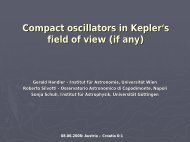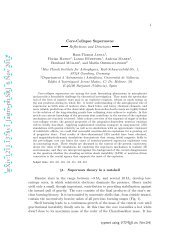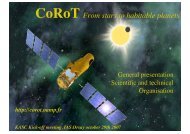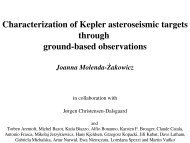PDF file.
PDF file.
PDF file.
- No tags were found...
Create successful ePaper yourself
Turn your PDF publications into a flip-book with our unique Google optimized e-Paper software.
A4 ASTROPHYSICS I SUMMER 1999EXERCISE 2We consider the collapse of the central part of a star which leads to asupernova explosion. Assume that the collapse comprises 1M ⊙ where M ⊙ =1.989 × 10 33 g is the solar mass, and also that all matter in this part of thestar is converted into neutrons.a) Argue that the conversion of core matter into neutrons results in a neutrinoproduction and give a substantiated estimate of the total numberN ν of neutrinos produced through this process.Detailed models show that also other processes during the explosion contributeto the neutrino production. Thus, the total number of producedneutrinos during the supernova explosion is N ν,tot = 1.2 × 10 58 .b) The neutrinos produced have a mean energy of 10 MeV. Argue that thetotal energy emitted in neutrinos constitutes the dominant part of theenergy which is released by the gravitational collapse. It is assumedthat the core collapses to a radius of 10 km.Consider now the supernova SN1987A in the Large Magellanic Cloud.The distance from the supernova to the Earth was 50 kpc.c) Assume that the neutrino emission took place over a period of 10 s andthat the neutrinos are massless. Determine the average neutrino flux,corresponding to N ν,tot , on Earth.d) The neutrinos were detected with the Japanese Kamiokande detectorthrough scattering of neutrinos on electrons in water. The detector contained2000 tons of water, and the cross section for a reaction between aneutrino and an electron is 4 ×10 −43 cm 2 . Determine the total numberof reactions in the detector. (This number was actually observed!)e) If the neutrinos have a finite mass they move at velocities less thanthe speed of light. This causes a delay ∆t in their arrival relative tothe time of arrival corresponding to the speed of light. Show that forneutrinos from SN1987A( ) 10 MeV 2(mν c 2 ) 2∆t ≃ 2.5 s,E ν 10 eV2













